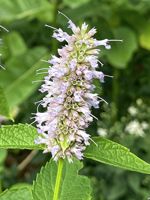Mon-Fri 9am - 5pm Mountain time
Tango Weigela vs Anise Hyssop
Agastache foeniculum
Weigela florida Tango
NOT AVAILABLE THIS SEASON - MIGHT RETURN
CUSTOM GROW
Anise Hyssop is a native perennial wildflower known for its fragrant spikes of small purple flowers. This plant is an excellent source of nectar and is highly attractive to a variety of bees and other pollinators. Deadheading spent flowers will encourage more blooms throughout the season.
Its aromatic leaves release an anise-like (licorice) scent when crushed. Both the leaves and seeds are edible and have been used in teas and as flavouring. Leaves can be harvested at any time, though the oil content is highest just past full bloom. Deer tend to avoid Anise Hyssop because of its strong-smelling leaves. This makes it a useful plant for positioning as a protective border around more vulnerable species.
Anise Hyssop spreads by seeds and rhizomes, but is less aggressive than other members of the mint family and is easy to remove if needed. Historically, it was planted in large numbers as a honey plant to support apiaries. Birds also feed on its seeds, adding to its ecological value.
Tango Weigela is one of the smallest weigelas. Its compact form makes it ideal for urban yards or areas with limited space. The red, funnel shaped flowers with yellow throats are eye catching and fragrant. Good for borders, hedges, and foundation plantings, you'll love this new addition to your yard.

